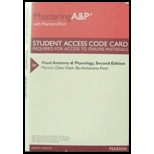
MasteringA&P with Pearson eText -- Valuepack Access Card -- for Visual Anatomy & Physiology
2nd Edition
ISBN: 9780321963437
Author: Frederic H. Martini, William C. Ober, Judi L. Nath, Edwin F. Bartholomew, Kevin Petti
Publisher: PEARSON
expand_more
expand_more
format_list_bulleted
Concept explainers
Question
Chapter 17, Problem 4CI
Summary Introduction
To explain: The training techniques other than drugs that Person P could try.
Introduction: Erythropoietin is a hormone primarily formed in the kidneys. It contributes a crucial role for red blood cell (RBC) production by inducing the bone marrow. RBCs carry oxygen from the lungs throughout the body.
Expert Solution & Answer
Want to see the full answer?
Check out a sample textbook solution
Students have asked these similar questions
Which of the following blood types would agglutinate if donated to a person with blood type A+? a. A- c. O+ b. O- d. B-
What characteristics of artificial blood is difficult to produce?
Label the components of the blood as indicated in the histological image below.
Chapter 17 Solutions
MasteringA&P with Pearson eText -- Valuepack Access Card -- for Visual Anatomy & Physiology
Ch. 17.1 - Prob. 1.1RCh. 17.1 - Prob. 1.2RCh. 17.1 - Prob. 1.3RCh. 17.1 - Prob. 2.1RCh. 17.1 - Prob. 2.2RCh. 17.1 - Prob. 2.3RCh. 17.1 - Prob. 3.1RCh. 17.1 - Prob. 3.2RCh. 17.1 - Prob. 3.3RCh. 17.1 - Prob. 1LO
Ch. 17.1 - Describe the important components and major...Ch. 17.1 - Prob. 3LOCh. 17.1 - Prob. 1SRCh. 17.1 - Prob. 2SRCh. 17.1 - Prob. 3SRCh. 17.1 - Prob. 4SRCh. 17.1 - Prob. 5SRCh. 17.1 - Prob. 6SRCh. 17.1 - Prob. 7SRCh. 17.1 - Prob. 8SRCh. 17.1 - Prob. 9SRCh. 17.1 - Prob. 10SRCh. 17.1 - Prob. 11SRCh. 17.1 - Prob. 12SRCh. 17.1 - Prob. 13SRCh. 17.1 - Prob. 14SRCh. 17.1 - Prob. 15SRCh. 17.2 - Prob. 1.1RCh. 17.2 - Prob. 1.2RCh. 17.2 - Prob. 1.3RCh. 17.2 - Prob. 2.1RCh. 17.2 - Prob. 2.2RCh. 17.2 - Prob. 2.3RCh. 17.2 - Prob. 3.1RCh. 17.2 - Prob. 3.2RCh. 17.2 - Prob. 3.3RCh. 17.2 - Prob. 4.1RCh. 17.2 - Prob. 4.2RCh. 17.2 - Prob. 4.3RCh. 17.2 - Prob. 5.1RCh. 17.2 - Prob. 5.2RCh. 17.2 - Prob. 5.3RCh. 17.2 - Prob. 6.1RCh. 17.2 - Prob. 6.2RCh. 17.2 - Prob. 6.3RCh. 17.2 - Prob. 7.1RCh. 17.2 - Prob. 7.2RCh. 17.2 - Prob. 7.3RCh. 17.2 - Prob. 8.1RCh. 17.2 - Prob. 8.2RCh. 17.2 - Prob. 8.3RCh. 17.2 - Prob. 1LOCh. 17.2 - Prob. 2LOCh. 17.2 - Prob. 3LOCh. 17.2 - Prob. 4LOCh. 17.2 - Prob. 5LOCh. 17.2 - Prob. 6LOCh. 17.2 - Prob. 7LOCh. 17.2 - Prob. 8LOCh. 17.2 - Prob. 1SRCh. 17.2 - Prob. 18SRCh. 17.2 - Prob. 19SRCh. 17.2 - Prob. 20SRCh. 17.2 - Prob. 21SRCh. 17.2 - Prob. 22SRCh. 17.2 - Prob. 23SRCh. 17.2 - Prob. 24SRCh. 17.2 - Prob. 25SRCh. 17.2 - Prob. 26SRCh. 17.2 - Prob. 27SRCh. 17.2 - Prob. 28SRCh. 17.2 - Prob. 29SRCh. 17.2 - Prob. 30SRCh. 17 - Prob. 1CRQCh. 17 - Prob. 2CRQCh. 17 - Prob. 3CRQCh. 17 - Prob. 4CRQCh. 17 - Prob. 5CRQCh. 17 - Prob. 6CRQCh. 17 - Prob. 7CRQCh. 17 - Prob. 8CRQCh. 17 - Prob. 9CRQCh. 17 - Prob. 10CRQCh. 17 - Prob. 11CRQCh. 17 - Prob. 12CRQCh. 17 - Prob. 13CRQCh. 17 - Prob. 14CRQCh. 17 - Prob. 15CRQCh. 17 - Prob. 16CRQCh. 17 - Prob. 17CRQCh. 17 - Prob. 18CRQCh. 17 - Describe the various types of leukemias.
Ch. 17 - Prob. 20CRQCh. 17 - Prob. 21CRQCh. 17 - Prob. 1CICh. 17 - Prob. 2CICh. 17 - Prob. 3CICh. 17 - Prob. 4CICh. 17 - Prob. 5CICh. 17 - Prob. 6CICh. 17 - Prob. 7CI
Knowledge Booster
Learn more about
Need a deep-dive on the concept behind this application? Look no further. Learn more about this topic, biology and related others by exploring similar questions and additional content below.Similar questions
- Which characteristics of normal blood is difficult to be produced artificially?arrow_forwardName six characteristics that describe blood, and explain the significance of each to health and homeostasis.arrow_forwardList the physical properties of blood and describe its components and key functions.arrow_forward
arrow_back_ios
arrow_forward_ios
Recommended textbooks for you
